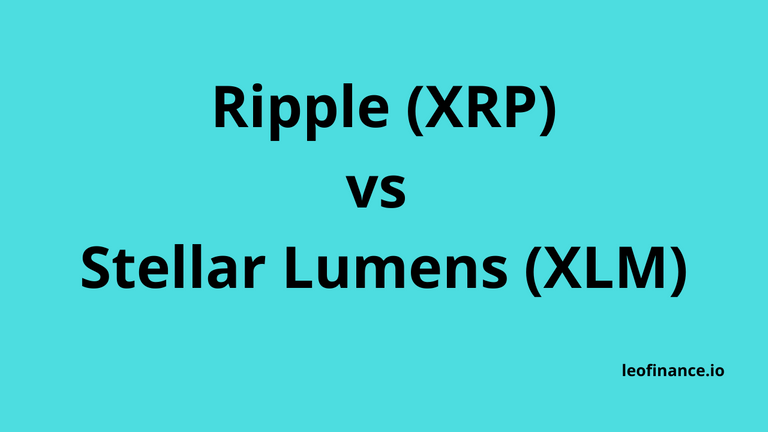Ripple (XRP) vs Stellar Lumens (XLM)
This section is a part of Ripple (XRP) Crypto Guide. In this section we are going to compare two blockchains - Ripple (XRP) vs Stellar Lumens (XLM).


Introduction
This guide is meant to show you unbiased feature set comparison of blockchains in discussion. Below table shows you the comparison points between the two blockchains.
| Ripple (XRP) | Stellar Lumens (XLM) |
| Ripple project started in 2012 as a Opencoin and later renamed into Ripple labs. | Stellar network began working on XLM in 2015. |
| Ripple labs has (XRP) as it's crypto coin built for the ripple blockchain. | Stellar network developed LUMENS (XLM) as it's cryptocoin for the blockchain. |
| Ripple XRP has the supply of max. supply of 100,000,000,000 XRP coins and circulating supply of 47,081,679,946 XRP coins. | Stellar Lumens has the max supply of supply of 50,001,806,812 XLM coins and circulating supply of 24,206,630,150 XLM coins. |
| Ripple network makes use of XRP ledger protocol for it's network consensus. | Stellar network makes use of it's own stellar consensus protocol. |
| Ripple labs XRP is being used in the financial networsk remittance and cross border payments through internal private banking networks. | Stellar Lumens makes use of the decentralized and open source blockchain networks for it's remittance and the cross border payments. |
| Ripple labs is a private entity and it's blockchain has the private nodes for the banks and financial institutes. | Stellar Lumens has the foundation governing the code, team and the blockchain network. |
| Ripple labs makes use of C++ as it's primary programming language for the crypto development. | Stellar network makes use of the C/C++, JavaScript and GO language for the blockchain development. |
| Ripple lab's XRP crypto network has the transaction fees in the range of 0.002 to 0.42. | Stellar Lumen's XLM has the transaction fees of around 0.00001 XLM per transaction. |
| Ripple network has the transaction per second recorded as 3 to 5 TPS on it's blockchain. | Stellar network has the 250 transactions per second on it's ledger. |
| Ripple Labs has XRP ledger for smart contract specific to it's private network nodes. | Stellar network makes use of the constraint based smart contracts expressed through it's execution. |
| Ripple labs XRP is available in external exchanges for staking, lending and other exchange usage scenario. | Stellar Lumens too is available for the external exchanges, staking, lending and other exchange usage scenario. |

You can check out the Ripple Coinmarket for more accurate numbers.
You may also want to check the comparison of Ripple (XRP) vs Ethereum (ETH).
Ripple (XRP) OR Stellar Lumens (XLM) - Which one to choose?
Ripple labs is a private entity controlling the centralized blockchain Ripple with it's XRP crypto coin for the payment networks and private banks. Whereas the Stellar network's blockchain has the XLM that connects banks through open source and decentralized blockchain.
Choosing between the two largely depends on the market demand and the investor interests. For average consumer who wants to make use of one from the two they'd find the XLM lot better for the cross border payments.

Conclusion
Ripple labs being a centralized and the private payment network, it's not really the right choice for those who are seeking the decentralized and open source crypto blockchain. Stellar Lumens despite having the leadership problems presents a decentralized and open source blockchain for the cross border payments. Choice at the end, depends on the investors and the end users.
Posted Using LeoFinance Beta
I personally cannot consider XRP a "Cryptocurrency" IMO, being so centralized in the hands of a Private company.
XLM instead looks much better for me